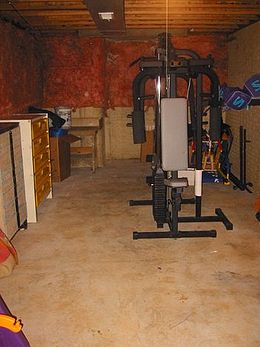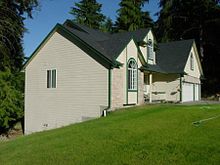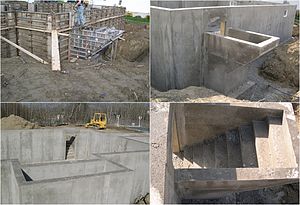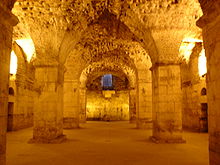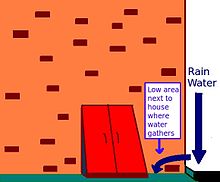- Basement
-
This article is about the section of a building. For other uses, see Basement (disambiguation).
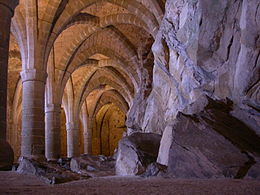 Chillon Castle (Château de Chillon) basement
Chillon Castle (Château de Chillon) basement
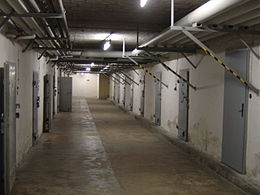 A Stasi basement hallway
A Stasi basement hallway
A basement is one or more floors of a building that are either completely or partially below the ground floor. Basements are typically used as a utility space for a building where such items as the furnace, water heater, breaker panel or fuse box, car park, and air-conditioning system are located; so also are amenities such as the electrical distribution system, and cable television distribution point.
In British English, the word "basement" is used for underground floors of, for example, department stores, but the word is only used with houses when the space below their ground floor is habitable, with windows and (usually) its own access. The word cellar is used to apply to any large underground room. A subcellar is a cellar that lies further underneath.[1]
Contents
Purpose, geography, history
A basement can be used in almost exactly the same manner as an additional above-ground floor of a house or other building. However, the use of basements depends largely on factors specific to a particular geographical area such as climate, soil, seismic activity, building technology, and real estate economics.
Basements in small buildings such as single-family detached houses are rare in wet climates such as Great Britain and Ireland where flooding can be a problem, though they may be used on larger structures. However, basements are considered standard on all but the smallest new buildings in many places with temperate continental climates such as the American Midwest and the Canadian Prairies where a concrete foundation below the frost line is needed in any case, to prevent a building from shifting during the freeze-thaw cycle. Basements are much easier to construct in areas with relatively soft soils, and may be foregone in places where the soil is too compact for easy excavation. Their use may be restricted in earthquake zones, because of the possibility of the upper floors collapsing into the basement; on the other hand, they may be required in tornado-prone areas as a shelter against violent winds. Adding a basement can also reduce heating and cooling costs as it is a form of earth sheltering, and a way to reduce a building's surface area-to-volume ratio. The housing density of an area may also influence whether or not a basement is considered necessary.
Historically, basements have become much easier to build (in developed countries) since the industrialization of home building. Large powered excavation machines such as backhoes and front-end loaders have reduced the time and manpower needed to dig a basement dramatically as compared to digging by hand with a spade, although this method may still be used in the developing world.
For most of its early history, the basement took one of two forms. It could be little more than a cellar, or it could be a section of a building containing rooms and spaces similar to those of the rest of the structure, as in the case of basement flats and basement offices.
However, beginning with the development of large, mid-priced suburban homes in the 1950s, the basement, as a space in its own right, gradually took hold. Initially, it was typically a large, concrete-floored space, accessed by indoor stairs, with exposed columns and beams along the walls and ceilings, or sometimes, walls of poured concrete or concrete cinder block.
Types of basement
Daylight basement
A daylight basement or a "walk-out basement" is contained in a house situated on a slope, so that part of the level is above ground, with a doorway to the outside. The part of the floor covered by the ground can be considered the true basement area. From the street, some daylight basement homes appear to be one storey. Others appear to be a conventional two storey home from the street (with the buried, or basement, portion in the back). Occupants can walk out at that point without having to use stairs. For example, if the ground slopes downwards towards the back of the house, the basement is at or above grade (ground level) at the back of the house. It is a modern design because of the added complexity of uneven foundations; where the basement is above grade, the foundation is deeper at that point and must still be below the frostline.
Full-size windows can be installed in a daylight basement. These can provide exits for bedrooms (building bedrooms in basements is usually illegal without an outside escape). Ventilation is improved over fully buried basement homes, with less dampness and mould problems.
Daylight basements can be used for several purposes - as a garage, as maintenance rooms, or as living space. The buried portion is often used for storage, laundry room, hot water tanks, and HVAC.
Daylight basement homes typically appraise higher than standard-basement homes, since they include more viable living spaces. In some parts of the U.S. however the appraisal for daylight basement space is half that of ground and above ground level square footage. Designs accommodated include split-foyer and split-level homes. Garages on both levels are sometimes possible. As with any multi-level home, there are savings on roofing and foundations.[2][3]
Look-out basement
In a "look-out" basement, the basement walls extend sufficiently above ground level that some of the basement windows are above ground level. Where the site slopes gently and is insufficient for a walk-out basement, a look-out basement tends to result. Sometimes, a look-out basement is deliberately constructed even on a flat site. The advantage is that the basement windows are all above grade. The disadvantage is that the main floor entry is above grade as well, necessitating stairs to get up to the main floor. The raised bungalow design solves this by lowering the entry half-way between the main floor and basement to make a dramatic, high-ceiling foyer. It is a very economical design because the basement is shallower, and excavation costs are minimized.
Walk-up basement
A “walk-up” basement is any basement that has an exterior entrance via a stairwell. Some designs cover the stairwell with angled “basement doors” or "bulkhead doors" to keep rain water from accumulating in the stairwell.
When initially built, the main floor joists are often exposed and the walls and floors concrete (with insulation, where appropriate). Unfinished basements allow for easy access to the main floor for renovation to the main floor. Finishing the basement can add significant floor space to a house (doubling it in the case of a bungalow) and is a major renovation project
Cellar
A cellar is a type of basement primarily used for the storage of food and drink (especially wine) for use throughout the year. A cellar is intended to remain at a constant cool (not freezing) temperature all year round and usually has either a small window/opening or some form of air ventilation (air/draught bricks, etc.) in order to help eliminate damp or stale air. Cellars are more common in the UK in older houses, with most terraced housing built during late 19th, and early 20th Century having cellars. These were important shelters from air raids during World War II. In parts of the U.S. that are prone to tornadoes (See: Tornado Alley), cellars still serve as shelter in the event of a direct hit on the house from a tornado or other storm damage caused by strong winds.
Except for Britain, Australia and New Zealand, cellars are popular in most western countries. In the UK, almost all new homes built since the 1960s have no cellar or basement due to the extra cost of digging down further into the sub-soil and a requirement for much deeper foundations and water-proof tanking. The obverse has recently become common, where the impact of smaller home-footprints has led to roof-space being utilised for further living space and now many new homes are built with third-floor living accommodation. For this reason people tend to store food and drink in a garage. The majority of continental European houses have cellars,[citation needed] although a large proportion of people live in apartments or flats rather than houses. In North America, cellars usually are found in rural or older homes on the coasts and in the South. However, full basements are commonplace in new houses in the US Midwest and other areas subject to tornado activity or requiring foundations below the frost line.
Crawl space
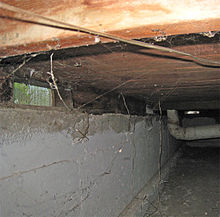 A typical crawl space showing Crawl space vents and concrete ratproofing. Ratproofing is a thin, irregular concrete covering applied over the dirt to prevent rodents from burrowing under the foundation wall and entering the crawl space.
A typical crawl space showing Crawl space vents and concrete ratproofing. Ratproofing is a thin, irregular concrete covering applied over the dirt to prevent rodents from burrowing under the foundation wall and entering the crawl space.
A crawl space (as the name suggests) is a type of basement in which one cannot stand up — the height may be as little as one foot, and the surface is often soil. They offer a convenient access to pipes, substructures and a variety of other areas that may be difficult or expensive to access otherwise. While a crawlspace cannot be used as living space, it can be used as storage, often for infrequently used items. Care must be taken in doing so, however, as water from the damp ground, water vapor (entering from crawlspace vents), and moisture seeping through porous concrete can create a perfect environment for mould/mildew to form on any surface in the crawlspace, especially cardboard boxes, wood floors and surfaces, drywall and some types of insulation.
Health and safety issues must be considered when installing a crawl space. As air warms in a home, it rises and leaves through the upper regions of the house, much in the same way that air moves through a chimney. This phenomenon, called the "stack effect," causes the home to suck air up from the crawlspace into the main area of the home. Mould spores, decomposition odours, and fecal material from dust mites in the crawlspace can come up with the air, aggravating breathing problems (such as asthma) and creating a variety of health-related problems.[4]It is usually desirable to finish a crawlspace with a plastic vapour barrier that will not support mould growth or allow humidity from the earth into the crawlspace. This helps insulate the crawlspace and discourages the habitation of insects and vermin by breaking the ecological chain in which insects feed off the mould and vermin feed on the insects, as well as creating a physical inorganic barrier that deters entrance into the space. Vapour barriers can end at the wall or be run up the wall and fastened to provide even more protection against moisture infiltration. Some pest control agencies recommend against covering the walls as it complicates their job of inspection and spraying. Almost unheard of as late as the 1990s, vapour barriers are becoming increasingly popular in recent years, in fact, the more general topic of conditioned vs. unconditioned crawlspaces has enjoyed much research over the last decade.
Design and structural considerations
Basement of Diocletian's Palace
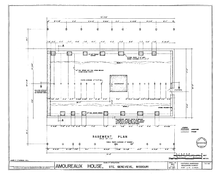 measured drawing showing basement plan and structural foundations of the Amoureaux House in Ste. Geneviève, Missouri
measured drawing showing basement plan and structural foundations of the Amoureaux House in Ste. Geneviève, Missouri
 Floorplan of Church of Tithes, Kiev, prior to 1828 rebuild
Floorplan of Church of Tithes, Kiev, prior to 1828 rebuild
Structurally, for houses, the basement walls typically form the foundation. In warmer climates, some houses do not have basements because they are not necessary (although many still prefer them). In colder climates, the foundation must be below the frost line. Unless constructed in very cold climates, the frost line is not so deep as to justify an entire level below the ground, although it is usually deep enough that a basement is the assumed standard. In places with oddly stratified soil substrata or high water tables, such as most of Texas, Oklahoma, Arkansas, and areas within 50 miles (80 km) of the Gulf of Mexico, basements are usually not financially feasible unless the building is a large apartment or commercial structure. In many earthquake-prone areas, such as Southern California, basements are not common because of the possibility of collapse during an earthquake.
Some designs elect to simply leave a crawl space under the house, rather than a full basement. Most other designs justify further excavations to create a full-height basement, sufficient for another level of living space. Even so, basements in Canada and the northern United States were typically only 7 feet 10 inches (2.39 m) in height, rather than the standard full 8 feet (2.44 m) of the main floors.[5] Older homes may have even lower basement heights as the basement walls were concrete block and thus, could be customized to any height. Modern builders offer higher basements as an option. The cost of the additional depth of excavation is usually quite expensive. Thus, houses almost certainly never have multi-story basements though 9 feet (2.74 m) basements heights are a frequent choice among new home buyers. For large office or apartment buildings in prime locations, the cost of land may justify multi-story basement parking garages.
The concrete floor in most basements is structurally not part of the foundation; only the basement walls are. If there are posts supporting a main floor beam to form a post and beam system, these posts typically go right through the basement floor to a footing underneath the basement floor. It is the footing that supports the post and the footing is part of the house foundation. Load-bearing wood-stud walls rest directly on the concrete floor. Under the concrete floor is typically gravel or crushed stone to facilitate draining. The floor is typically four inches (100 mm) thick and it rests on top of the foundation footings. The floor is typically sloped towards a drain point, in case of leaks.
Since warm air rises, basements are typically cooler than the rest of the house. In summer, this makes basements damp, due to the higher relative humidity. Dehumidifiers are recommended. In winter, additional heating, such as a fireplace or baseboard heaters may be required. A well-defined central heating system may minimize this requirement. Heating ducts typically run in the ceiling of the basement (since there is not an empty floor below to run the ducts). Ducts extending from the ceiling down to the floor help heat the cold floors of the basement. Older or cheaper systems may simply have the heating vent in the ceiling of the basement.
The finished floor is typically raised off the concrete basement floor. In countries such as Canada, laminate flooring is an exception: It is typically separated from the concrete by only a thin foam underlay. Radiant heating systems may be embedded within the concrete floor. Even if unfinished and unoccupied, basements are heated in order to ensure relative warmth of the floor above, and to prevent water supply pipes, drains, etc. from freezing and bursting in winter. It is recommended that the basement walls be insulated to the frost line. In Canada, the walls of a finished basement are typically insulated to the floor with vapor barriers to prevent moisture transmission. However, a finished basement should avoid wood or wood-laminate flooring, and metal framing and other moisture resistant products should be used. Finished basements can be costly to maintain due to deterioration of waterproofing materials or lateral earth movement etc. Below-ground structures will never be as dry as one above ground, and measures must be taken to circulate air and dehumidify area. [1]
Drainage considerations
Basement floor drains need to be filled regularly to prevent the trap from drying out and sewer gas from escaping into the basement. The drain trap can be topped up automatically by the condensation from air conditioners or high-efficiency furnaces. A small tube from another downpipe is sometimes used to keep the trap from drying out. Some[who?] advocate the use of special radon gas traps. In areas where storm and sanitary sewers are combined, and there is the risk of sewage backing up, backflow prevention devices in all basement drains may be mandated by code and definitely are recommended even if not mandated.
The main water cut-off valve is usually in the basement. Basements often have “clean outs” for the sanitary and storm sewers, where these pipes can be accessed. The storm sewer access is only needed where the weeping tiles drain into the storm sewers.
Other than with walk-out or look-out basements, windows in basements require a well and are below grade. Clear window well covers may be required to keep the window wells from accumulating rain water. There should be drains in the window well, connected to the foundation drains.
If the water table outside the basement is above the height of the basement floor, then the foundation drains or the weeping tiles outside the footings may be insufficient to keep the basement dry. A sump pump may be required. It can be located anywhere and is simply in a well that is deeper than the basement floor.
Even with functioning sump pumps or low water tables, basements may become wet after rainfall, due to improper drainage. The ground next to the basement must be graded such that water flows away from the basement wall. Downspouts from roof gutters should drain freely into the storm sewer or directed away from the house. Downspouts should not be connected to the foundation draintiles. If the draintiles become clogged by leaves or debris from the rain gutters, the roof water would cause basement flooding through the draintile. Damp-proofing or waterproofing materials are typically applied to outside of the basement wall. It is virtually impossible to make a concrete wall waterproof, over the long run, so drainage is the key. There are draining membranes that can be applied to the outside of the basement that create channels for water against the basement wall to flow to the foundation drains.
Where drainage is inadequate, waterproofing may be needed. There are numerous ways to waterproof a basement, but most systems fall into one of three categories:
- Tanking – Systems that bond to the basement structure and physically hold back groundwater.
- Cavity Drainage – Dimpled plastic membranes are used to line the floors and walls of the basement, creating a "drained cavity." Any water entering this drained cavity is diverted to a sump pump and pumped away from the basement.
- Exterior Foundation Drain – Installing an exterior foundation drain that will drain away by gravity is the most effective means to waterproof a basement. An exterior system allows water to flow away from the basement without using pumps or electricity. An exterior drain also allows for the installation of a waterproof membrane to the foundation walls.
The waterproofing system can be applied to the inside or the outside walls of a basement.[6] When waterproofing existing basements it is much cheaper to waterproof the basement on the inside. Waterproofing on the outside requires the expense of excavation, but does offer a number of advantages for a homeowner over the long term. Among them are:
- Gravity system
- No pumps or electrical wiring required
- Membrane applied to exterior walls to prevent dampness, mold, moisture, and soil gases from entering the home
- Permanent solution
Basement culture/finishings
Unfinished basement
This first unfinished design, found principally in spaces larger than the traditional cellar, is common in residences throughout America and Canada. One usually finds within it a water heater, various pipes running along the ceiling and downwards to the floor, and sometimes a workbench, a freezer or refrigerator, or a washer/dryer set. Boxes of various materials, and objects unneeded in the rest of the house, are also often stored there; in this regard, the unfinished basement takes the place both of the cellar and of the attic. Home workshops are often located in the basement, since sawdust, metal chips, and other mess or noise are less of a nuisance there. The basement can contain all of these objects and still be considered to be “unfinished,” as they are either mostly or entirely functional in purpose.
Finished basement
In this case the space has been designed, either during construction or at a later point by the owners, to function as a fully habitable addition to the house. Frequently most or all of the basement is used as a recreation room or living room, but it is not uncommon as well to find there (either instead of or alongside the living/recreation room) a guest bedroom or teenager's room, a bathroom, a home office, a home gym, a home theater, a basement bar, a sauna, and one or more closets. Occasionally a part of the basement is unfurnished and is used for storage, a workshop, and/or a laundry room; when this is the case the water heater and furnace will also often be located there, although in some cases the entire basement is finished, and the water heater and furnace are boxed off into a closet.
Partially finished basement
The main point of distinction between this type of basement and the two others lies in its being either entirely unmodified (unlike the finished basement) beyond the addition of furniture, recreational objects and appliances, and/or exercise equipment on the bare floor, or slightly modified through the installation (besides any or all of the aforementioned items) of loose carpet and perhaps simple light fixtures. In both cases, the objects found there—many of which could be found in a finished basement as well—might include the following: weight sets and other exercise equipment; the boom boxes or entertainment systems used during exercise; musical instruments (which are not in storage, as they would technically be in an unfinished basement; an assembled drum set would be the most easily identified of these); fussball tables, chairs, couches and entertainment appliances of lesser quality than those in the rest of the house; refrigerators, stand-alone freezers, and microwaves (the first and the second being also sometimes used as supplementary storage units in an unfinished basement); and sports pennants and/or other types of posters which are attached to the walls.
As the description suggests, this type of basement, which also might be called “half-finished,” is likely used by teenagers and children. The entire family might utilize a work-out area. It is also common to have a secondary (or primary) home office in a partially finished basement, as well as a workbench and/or a space for laundry appliances.
Toilets and showers sometimes exist in this variety of basement, as many North American basements are designed to allow for their installation.
Fully finished basement - retro fit
In London the construction of finished retrofit basements is big business with a large number of project in the 100-200 square meter bracket. There are a smaller number of project in the 200-500 square meter bracket under construction. It is also not unusual to see multi level retro-fit basements. These are considerable works of civil engineering and require some skill and intuitive understanding as well as good engineering. Given the scale of the civil engineering problems are rare but it is notable that the long established companies have a significantly better track record than the more recent start ups.
Retro fit - reasons for it
Given high property values digging a basement actually creates capital value at between 2-5 times cost in most areas of central London. In a lot of central London homes there simply isn't the space to extend sideways or up so down is the only option for a lot families hard pressed for space and squeezed out of the moving market by high stamp duty.
Real estate floorspace measures
In Canada, historically the basement area was excluded from advertised square footage of a house as it was not part of the living space. For example, a "2,000-square-foot bungalow" would, in reality, have 4,000 square feet (370 m2) of floor space. More recently, finished space has become increasingly acceptable as a measure which includes the developed basement areas of a home. Due to fire code requirements, most jurisdictions require an emergency egress (through either egress-style windows, or, in the case of a walk-out basement, a door) to include the basement square footage as living space.
See also
References
- ^ Subcellar – definition of Subcellar by the Free Online Dictionary, Thesaurus and Encyclopedia.
- ^ Woodson, R. Dodge. Build Your Dream Home for Less. Cincinnati: Betterway Books, 1985, pp 60-61.
- ^ Zeller, Dirk. Success as a Real Estate Agent for Dummies. Wiley, 2006, p. 209
- ^ http://healthlink.mcw.edu/article/926104064.html
- ^ "The hole story". Detroit Free Press. April 21, 2002. Archived from the original on 2008-06-09. http://web.archive.org/web/20020602163904/http://www.freep.com/realestate/renews/house21_20020421.htm.
- ^ "Signs of a Leaky Basement & Basement Waterproofing Issues". http://aquaguard-pittsburgh.com/pittsburgh_basement_waterproofing.php.
External links
- National Research Council (Canada) Basement subject search
- HealthLink's Article on Mold Allergies
- Dry Basements and Crawl Spaces, Morgan Powell and Danny Rogers, Kansas State University, April 2008, 8 pages, illustrated
- Avoiding Basement Waterproofing Scams
- Wet basement waterproofing solutions
Rooms, spaces, and architectural elements Public areas - Airport lounge
- Auditorium
- Cafeteria
- Classroom
- Changing room / Locker room
- Conference hall
- Doctor's office
- Function hall
- Mailroom
- Library
- Lobby
- Office
- Refectory
- Restroom
- Security
- Waiting room
Passages and spaces Utility and storage - Attic
- Basement
- Box room / Carport
- Cloakroom
- Closet
- Electrical room
- Equipment room
- Furnace room / Boiler room
- Garage
- Janitorial closet
- Laundry room / Utility room
- Mechanical room / floor
- Pantry
- Root cellar
- Semi-basement
- Studio
- Server room
- Wardrobe
- Workshop
- Vault
- Wine cellar
- Wiring closet / Demarcation point
Shared residential rooms Private rooms Great house areas - Ballroom
- Butler's pantry
- Buttery
- Drawing room
- Fainting room
- Great chamber
- Great hall
- Larder
- Long gallery
- Lumber room
- Parlour
- Root cellar
- Salon
- Saucery
- Scullery
- Servants' hall
- Servants' quarters
- Smoking room
- Solar
- Spicery
- Stillroom
- Undercroft
Other areas Architectural elements Related terms - Building
- Furniture
- House
- House plan
- Rooms
Categories:- Rooms
- Building engineering
- Structural engineering
- Subterranea (geography)
- Food storage
Wikimedia Foundation. 2010.

